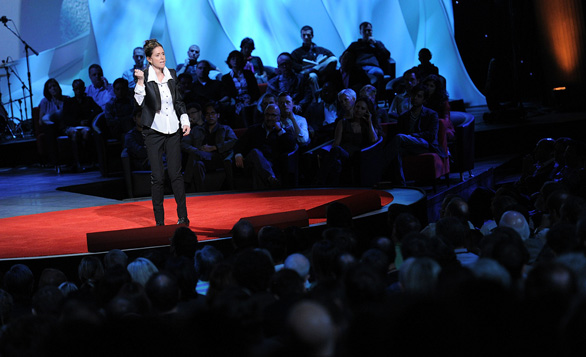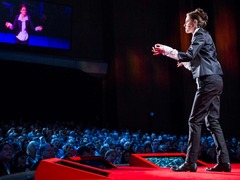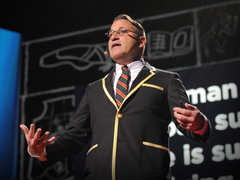
Julie Taymor shares her Spider-Man: Turn on the Dark experience at TED2011. Photo: James Duncan Davidson
Julie Taymor, the director behind Frida, Across the Universe and the Broadway reimagining of The Lion King, creates productions that tickle the senses. Filled with saturated colors, offbeat imagery, stacatto movement and big sound — each of her productions shares her unique style, yet manages to be completely distinct.
 Julie Taymor: Spider-Man, The Lion King and life on the creative edge
In today’s talk, Taymor shares with raw honesty the creative struggle that goes into each of her works, including the super-sized Broadway musical Spider-Man: Turn Off the Dark. Given just before Taymor split from the production over creative direction, she reveals what she was hoping to achieve with the play — a “comic book coming alive” in three dimensions all around the audience.
Julie Taymor: Spider-Man, The Lion King and life on the creative edge
In today’s talk, Taymor shares with raw honesty the creative struggle that goes into each of her works, including the super-sized Broadway musical Spider-Man: Turn Off the Dark. Given just before Taymor split from the production over creative direction, she reveals what she was hoping to achieve with the play — a “comic book coming alive” in three dimensions all around the audience.
But perhaps even more interestingly for any creative person, Taymor describes in this talk how she begins each project.
“I start with the notion of the ideograph,” she explains. “An ideograph is a Japanese brush painting — three strokes and you get the whole bamboo forest,” she says. “I go to the concept of The Lion King and say, ‘What is the essence of it? What is the abstraction? If I were to reduce this entire story into one image, what would it be?’ The circle. It’s so obvious.”
For The Tempest, her big screen adaptation began with the image of a sandcastle, the thing we build that always fades.
So much is made in the creative world of “finding your voice.” But just as hard is figuring out your process — how you work, and the way you like to begin a project. Below, read illuminating quotes from some filmmakers, writers, artists, musicians and designers who, like Taymor, have given insight into the way that they like to work.
 Philippe Starck: Design and destiny
Philippe Starck, designer
Philippe Starck: Design and destiny
Philippe Starck, designer
Where he starts: Thinking about who will use a product
“I try to not make the object for the object, but for the result — for the profit of the human being, the person who will use it. If we take the toothbrush — I don’t think about the toothbrush. I think, ‘What will be the effect of the brush in the mouth?’ And to understand the effect of the toothbrush in the mouth, I must imagine: Who owns this mouth? What is the life of the owner of this mouth? In what society [does] this guy live? What civilization creates this society? What animal species creates this civilization? When I arrive … at the level of animal species, that becomes real interesting.” [From his TED Talk]
JJ Abrams, filmmaker
Where he starts: Listening to the script
“I try to approach a project from what it’s asking. What does it need to be? What is it demanding? With Star Wars: Episode VII, one has to take into account what has preceded it — what worked, what didn’t. There are cautionary tales for anything you take on that has a legacy — things you look at and think, ‘I want to avoid this or that, or I want to do more of something.’ But even that feels like an outside-in approach, and it’s not how I work. For me, the key is when you have a script; it’s telling you what it wants to be.” [MovieWeb.com]
Steve Jobs, technology visionary
Where he started: Making connections
“Creativity is just connecting things. When you ask creative people how they did something, they feel a little guilty because they didn’t really do it — they just saw something. It seemed obvious to them after a while. That’s because they were able to connect experiences they’ve had and synthesize new things. And the reason they were able to do that was that they’ve had more experiences or they have thought more about their experiences than other people.” [Wired]
 Elizabeth Gilbert: Your elusive creative genius
Elizabeth Gilbert, writer
Elizabeth Gilbert: Your elusive creative genius
Elizabeth Gilbert, writer
Where she starts: Preparing for the struggle
“I had this encounter recently where I met the extraordinary American poet Ruth Stone, … When she was growing up in rural Virginia, she would be out working in the fields and she said she would feel and hear a poem coming at her from over the landscape … She knew that she only had one thing to do at that point, and that was to, in her words ‘run like hell.’ … She said there were points where she would almost miss it, right? So she’s running to the house and she’s looking for the paper and the poem passes through her and she grabs a pencil just as it’s going through her and then, she said, it was like she would reach out with her other hand and she would catch it. … That’s not at all what my creative process is — I’m not the pipeline! I’m a mule and the way that I have to work is that I have to get up at the same time every day, and sweat and labor and barrel through it really awkwardly.” [From her TED Talk]
Patti Smith, poet and musician
Where she starts: Improvising on thoughts or dreams
“I write songs when I’m by myself, like walking along the beach, and a song comes in my head. Or I wake up from a dream, like ‘Blakean Year.’ … Sometimes I write melodies that are too complex and I can’t find them on the guitar, because I only know about eight chords. So I take them to Lenny [Kaye] or Tony [Shanahan] and they transcribe them into a song. Other songs, they just come in my head and I sing them out loud, and the band finds the place, and they adjust it. For myself, the simpler format the better. ‘Gandhi’ is nine minutes on one chord. It’s an improvisation. ‘Radio Baghdad’ was completely improvised. I didn’t know the lyrics, but I knew I wanted to speak out against the invasion of Iraq … [Improvising is] easier for me than to sit and write verse-chorus. Writing lyrics, sometimes, is torturous because I make them too complicated, and sometimes burden a song with complicated language. For me, it’s freedom just to go and focus myself and see where my horse takes me.” [American Songwriter]
Marina Abramovic, performance artist
Where she starts: Observing everyday life in interesting spaces
“I never use a studio to work … You have to get new ideas from life … For me the most important spaces to be are the spaces in between — like in airports or lobbies of hotels — when you’re leaving one space and you arrive to another space. Before you start to make new habits you’re really open to destiny, you’re more perceptive, you see things. If you ask someone who has made the same commute to work everyday for 25 years to describe his own door, he probably couldn’t do it. But if you bring the same person to Japan and ask him afterwards to describe something, he could do it because his perception would be open.” [The-Talks.com]
 Chip Kidd: Designing books is no laughing matter. OK, it is.
Chip Kidd, book designer
Chip Kidd: Designing books is no laughing matter. OK, it is.
Chip Kidd, book designer
Where he starts: With an image, like Taymor
“The stories can be anything and some of them are actually true. But they all have one thing in common: They all need to look like something. They all need a face. Why? To give you a first impression of what you are about to get into … A book designer gives form to content, but also manages a careful balance between the two. A book cover is a distillation. It is a haiku, if you will, of the story.” [From his TED Talk]
Wes Anderson, filmmaker
Where he starts: Resisting the urge to think too deeply about meaning
“If somebody asks me about the themes of something I’m working on, I never have any idea what the themes are … Somebody tells me the themes later. I sort of try to avoid developing themes. I want to just keep it a little bit more abstract. But then, what ends up happening is, they say, ‘Well, I see a lot here that you did before, and it’s connected to this other movie you did,’ and … that almost seems like something I don’t quite choose. It chooses me.” [KCRW]
Rufus Wainwright, musician
Where he starts: In a blank space
“I work in an office when I am working — a very bland office with nothing on the walls. It is just a desk and something to type on and my piano and that is where I write my songs. There is no visual imagery around, there is no window to look out and there is certainly no music. To be honest, I feel that if I am not creating my sense of self plummets so low — my feelings about myself and my self-esteem take such a rapid nose-dive — that I have to get back in the game and start doing something again just to feel like I am engaged in the world.” [The-Talks.com]
T.S. Eliot, writer
Where he starts: Breaking through routine
“To me it seems that at these moments, which are characterised by the sudden lifting of the burden of anxiety and fear which presses upon our daily life so steadily that we are unaware of it, what happens is something negative: that is to say, not ‘inspiration’ as we commonly think of it, but the breaking down of strong habitual barriers — which tend to re-form very quickly. Some obstruction is momentarily whisked away.” [Brainpickings]
Comments (12)
Pingback: Friday Links | Writing and Rambling
Pingback: I share something with T. S. Eliot | An entrepreneurial life
Pingback: Futureseek Daily Link Review; 1 August 2013 | Futureseek Link Digest